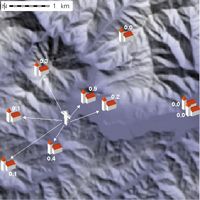
Digital model of soundscape.
The main motivation behind this article is to encourage new ways of approaching landscapes (i.e. 'listening to' instead of just 'looking at' them). This article challenges the privileged status of vision in modern humanistic-oriented GIS studies and thereby stresses the importance of multisensuous approaches within the study of past landscapes.
The article is divided into three parts. Firstly, it offers some theoretical perspectives on the perception of sound and its role in social life, and reviews some conceptual problems concerning modelling perception within GIS.
Secondly, it guides the reader through the process of constructing a digital soundscape model. The main goal of this article is to develop tools and approaches to understand past soundscapes. The process of creating a soundscape model is illustrated using an example from the late medieval soundscape of church bells in Polhograjsko hribovje, Slovenia.
Thirdly, the article offers some technical and mathematical background to the model and presents the use of the software package which is freely available with the paper.
The model presented is still in its infancy and much discussion and further development need to be undertaken. Its rationale and potential are addressed here.
Keywords: landscape archaeology, GIS, sound, soundscapes, perception
Go to Table of Contents
* Dimitrij Mlekuz
Department of Archaeology
Faculty of Arts
University of Ljubljana
Slovenia
Email: dimitrij.mlekuz@uni-lj.si
© Internet Archaeology
URL: http://intarch.ac.uk/journal/issue16/6/index.html
Last updated: Thur Nov 11 2004